


Here are some photos that Nancy and I took during the '07 season at Maxton, NC. These photos were taken in April, at the event that's promoted as the Hot Rod Magazine Top Speed Challenge. Here's a link to the web page. Maxton is the town where the East Coast Timing Association holds meets about five times a year -- on a closed airstrip at a small airport (you'll see old airplanes in the background of some of the photos). The strip was built in WWII days as a glider pilot training strip -- that's why there's a turn about a hundred yards after the start line. That is, the glider would be attached to the tow plane by a cable, and the glider would be offset to the side so when the plane started moving -- the geometry of the angle would allow the plane to gain a bit of speed before the full weight of the glider tried to slow the plane. Here's a little bit from the ECTA website, including an aerial view (scroll down when you get there). Okay -- Maxton is the land speed racer's only place to run east of the Mississippi River. It's a paved track, so there are big differences between there and Bonneville (traction and potholes!). And many of the racers at Maxton don't go to the Salt because of the - well, the salt -- that ends up all over, under, around, and through the race vehicles. Here are some photos of Maxton vehicles and racers: |
|
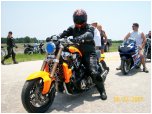 |
This is a Yamaha V-Max bike. See the blue headlight? Headlights and other glass are required to be taped -- so, in case of a crash, the track workers can pick up one piece of tape with lots of pieces of glass or plastic attached, instead of having to pick up zillions of pieces of shattered glass. |
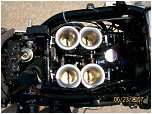 |
Here's a shot looking down at the air intakes for the V-Max. |
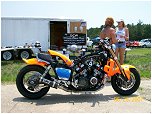 |
The V-Max, the air intake cover resting about where the rider sits. This bike is running in what's called the "naked bike" class -- that is, no streamlining is allowed in front of the rider -- no windshield, no fairing, nothing that would give the bike an aerodynamic advantage. The air "scoop" that's around the radiator doesn't give advantage -- in fact it makes things worse -- so it's allowed. Notice Nancy in the background, chatting with one of the other racers. The ECTA is a pretty small group of dedicated racers, and we all pretty much know everyone else in the group. It's very close-knit. Okay, back to the V-Max. Take a look at the Bonneville page here and you'll find a photo of me and a V-Max that I rode out there. Different bike, same idea -- naked, lots of power, fun ride! I went about 184 on my first and only pass down the course. |
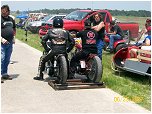 |
Some bikes don't have starter motors -- so other means are necessary to fire the engine. Here you see two bikes on rollers -- the one on the right starts up and starts the rollers moving, which makes the wheel of the bike on the left spin, and the rider then lets out the clutch (which connects the moving rear wheel to the engine), spins the engine, and -- if everything is right -- the engine starts. Got that? |
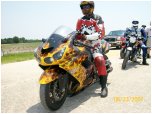 |
Here's a Kawasaki ZX14R -- with a custom paint job. I'd hazard a guess that the rider didn't spend much time trying to coordinate the paint job with the colors on his leathers. Just behind the rider's leg you can see a pair of horizontally-mounted pressure bottles, most likely holding nitrous oxide -- which is used as an oxidizer. In other words, the nitrous supplies a bunch of extra oxygen, and the engine computer tells the fuel injectors to squirt in a bunch of extra fuel -- and the result is more horsepower. Or, if things aren't calibrated correctly, the result is a blown up engine. Don't ask me how I know! |
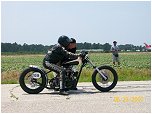 |
Here's a side view of the bike that was started on the rollers. This is a minimalist's bike, hey? You can see the tail section of one of the airplanes here, as well as the cotton field that surrounds the race track itself. The planes are out of service -- and used for training of security people. It's a strictly-enforced violation for us racers to go anywhere near the planes, so I won't be including any close-up photos of them. |
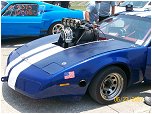 |
Whoa! Look at the size of that blower! And also notice the exhaust outlets in front of the front tires. This isn't as unusual as you might expect. The route the exhaust headers have to follow to get from engine to outside is always crooked and twisty -- and there's no reason not to have them dump to the atmosphere in front of the tires instead of behind. This is racing -- we don't have to worry about exhaust getting into the eyes of folks riding in the back seat as we mosey down the lane on the way to the local convenience store, so point the headers wherever it is convenient. |
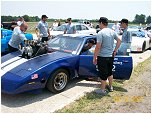 |
Here's a better shot of the entire car, supercharger and all. Even with the car showing -- it is pretty big, hey? |
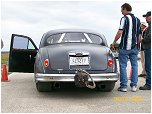 |
Okay. Many of the cars at the Hot Rod event are street-legal, many of 'em are even driven to the event. So -- imagine yourself at the stoplight near home and you look in front of you and see a Jaguar. Nice older model, but there's something different about it. Is it the parachute that's on the back? Or the tires that are really WIDE! How about the big dual exhaust pipes? Yup, this is a Jag -- but not the kind your Uncle from England drove, no doubt. |
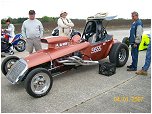 |
This A/GMR - engine size class "A", burns gasoline (not nitromethane or nitrous oxide or alcohol), modified roadster (not strictly duplicating a production roadster but with many similarities) is a good example of a specially-built car. Let's see -- big block motor, most likely Chevy. That tube that hooks into the headers is a vent from the crankcase so oil and other stuff that builds up down in there can be released into the atmosphere, but is mixed with the hot exhaust so it vaporizes instead of spraying oil on the track. Note the wing on the top of the roll cage -- the wing doesn't add too much drag, but does give some down force as speeds get higher, and that means more traction to reduce wheelspin at high speed. |
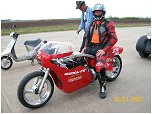 |
Here's Mark Wozniak astride an unusual bike built to fit into a specific class. It's powered by a Harley-Davidson type motor, but in a Suzuki-style chassis. Oh, yeah, and notice our pit bike right next to Mark's ride. This photo was taken in the motorcycle inspection area. I'm a tech inspector for bikes at Maxton and Bonneville, so I get to see many bikes up really close. |
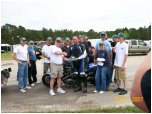 |
Bill gets his 200 MPH Club hat. I think I've explained it elsewhere, but in case you didn't see it there -- to gain membership in a 200 MPH Club requires setting a record over 200 mph, or breaking an existing record over 200, or setting a record that exceeds a pre-determined minimum speed over 200. It's not just going 200 mph. At the end of each event the members of the 2 Club hold an induction ceremony where the new member(s) is given his hat (here being given by Scott Guthrie, a racer Nancy and I know well, who has more than 200 official timing slips for runs over 200 MPH!), and where the present members welcome him to the group. I'm in the ECTA and the Bonneville 2 Clubs -- and someday hope to get into the Club at El Mirage dry lake, an old-time race venue northwest of Los Angeles. |